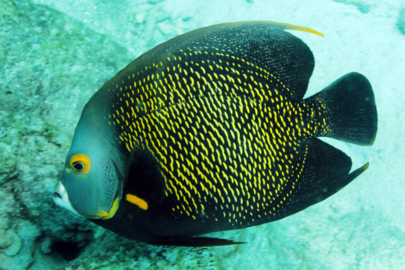Silver-gray. Marked with numerous dark, thin lines that radiate at a diagonal from midbody; black bar on hear runs across eye; yellowish submarginal band on rear dorsal, tail and anal fins.
Silver to white. black bar on head runs across eye; blackish border on rear of body, base of rear dorsal and anal fins.
Bright yellow ring around eye. All fins black except base of pectoral which is yellow.
What is the VFSP? | How do I access the database and summary reports? | How do I participate? | The Roving Diver Survey Method | Can I collect data while snorkeling or freediving? | Submitting your data | Can I still use Scantron forms? | When and where are surveys conducted? | How has the Volunteer Fish Survey Project expanded around the world? |
This report is the first publication of the RDT, and was initially given at the Gulf and Caribbean Fisheries Institute meeting in Spring 1994.
Roving diver data gathered by expert volunteers in the Florida Keys are presented and discussed. These data are found to be comparable to other Florida Keys published studies. Differences in the fish assemblages between the three regions of the Keys, the upper, lower, and the Dry Tortugas, are reported and evaluated. This paper was the first published account of the Roving Diver Technique (RDT).
This report is a summary of the first 3 years of the Fish Survey Project in the Florida Keys, with comparisons among FKNMS sites and with other distant regions. It demonstrates some ways in which data from the Project can be used.
This short paper, prepared after the second year of the Fish Survey Project, overviews the RDT and the more quantitative Stationary Sampling Technique. The advantages to the REEF RDT are discussed, including the information provided on fisheries-independent species and its simplicity. The author concludes that both methods can be used to answer a wide variety of monitoring and scientific questions, although each has advantages and disadvantages.
This manual describes all aspects of REEF data collection and processing. It also provides examples of interpretation of the Fish Survey Project data, and how REEF data are used for The Nature Conservancy's Conservation Profiles.
The quality of fish census data generated by REEF volunteers of various experience levels is examined and compared with data generated by experts. The similarity in species reported, the similarity in abundance category recorded, and the statistical power to detect change are used in the comparison. Species composition and structure is comparable between the skill levels. When sighted, most species are reported with similar abundance categories. The ability to detect change in many species is better for the nonexpert data, a result of higher survey effort for the nonexperts.



